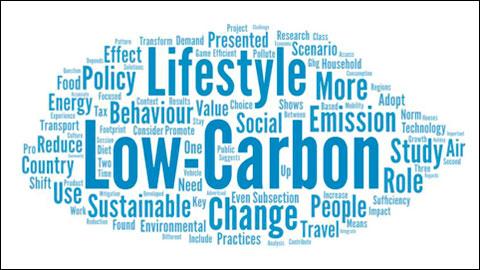Harnessing the Power of Low-Carbon Lifestyles for Global Emission Reduction
In light of the pressing challenges posed by climate change, the demand for innovative approaches has reached a critical juncture. A recent study underscores the significant impact that adopting low-carbon lifestyles can have in combating global warming. By exploring various methods through which individuals and communities can reduce their carbon footprints, researchers present a roadmap to drastically lower greenhouse gas emissions while promoting sustainable living practices. With urgency at an all-time high, this report highlights that choosing low-carbon options is not only an environmental necessity but also a chance for economic rejuvenation and enhanced social unity. As countries aim to achieve ambitious climate goals, it is imperative to reassess our daily routines and prioritize sustainability in our journey toward a greener planet.
Individual Actions in Sustainability: The Key to Achieving Carbon Neutrality
As climate change intensifies, personal choices play a crucial role in achieving carbon neutrality. The effects of everyday decisions can resonate throughout communities and economies, accelerating the shift towards sustainable practices. By embracing low-carbon lifestyles, individuals contribute significantly to collective emission reduction efforts while empowering themselves and those around them. The belief that individual actions are inconsequential is increasingly being challenged; when multiplied across millions of people, even minor adjustments can yield substantial results. For example, opting for energy-efficient appliances or conserving water are not merely suggestions; they represent actionable commitments anyone can adopt.
Furthermore, the transition towards sustainability extends beyond personal habits into consumption patterns and advocacy efforts. Individuals have the power to support local businesses, reduce reliance on plastics, and champion policies that emphasize sustainability at both local and national levels. Engaging with community educational programs fosters awareness and responsibility among residents, encouraging others to participate in carbon reduction initiatives. Below is a table showcasing some practical steps individuals can take:
| Action | Impact |
|---|---|
| Decrease meat intake | Diminish methane emissions from livestock farming. |
| Select public transport options | Lower individual carbon footprints. |
| Pursue renewable energy solutions | Aid clean energy production. |
| Engage in recycling practices | Curb waste generation while conserving resources. |
Community-Driven Solutions: Innovative Strategies for Low-Carbon Living
Around the world, communities are increasingly acknowledging the importance of implementing innovative strategies that foster low-carbon living environments. From bustling urban areas to serene rural settings, collaborative efforts can lead to meaningful impacts on emission reductions. Some effective solutions include:
- Solar Energy Cooperatives: By collectively utilizing solar power resources within neighborhoods, communities not only decrease their dependence on fossil fuels but also enjoy reduced energy expenses.
- Biking and Walking Programs: Cities may promote active transportation by enhancing infrastructure designed for cyclists and pedestrians—making these modes more accessible and attractive.
- Agricultural Co-operatives & Local Markets: strong > Supporting local food sources minimizes transportation-related emissions while strengthening community bonds.
- < strong >Implement Carbon Pricing:< / strong >/ li >
- Create Renewable Energy Subsidies:< li />Provide financial assistance targeting solar wind projects.< li />
- Pursue Public Awareness Campaigns:< li />Educate citizens regarding eco-friendly choices available today.< li />
- Edit Urban Planning Policies : Develop green spaces mixed-use developments fostering walking cycling habits.< li />
Additionally collaborating closely between government entities businesses maximizes potential impacts derived from eco-friendly initiatives incentivizing companies prioritizing environmentally conscious operational methods spurring innovation creating greener products .
A prime example includes establishing flexible regulatory frameworks rewarding organizations reducing overall footprint through following initiatives :
< Strong Initiative/ th > < Strong Expected Outcome/ th > >Green Certification Programs/ t d > >Encourages adoption sustainable business models./ t d > >Collaborative Research Grants/ t d > >Supports advancements green technologies./ t d > >Cleaner Production Agreements/ t d > >Minimizes waste enhances manufacturing efficiency./ t d Final Thoughts
Adopting low-emission lifestyles transcends mere individual choice; it represents collective responsibility essential unlocking vast potential global reductions CO₂ output . Recent findings underscore how daily routines—from commuting dietary preferences—significantly influence planetary health outcomes moving forward together we must cultivate heightened consciousness encourage responsible behavior aiming reverse detrimental trends associated ongoing climatic shifts affecting us all .
Policymakers enterprises citizens alike share pivotal roles navigating this transformative journey ahead though challenging rewards—a healthier environment future generations await us if we commit informed decisions contributing resilient world characterized lower emissions .
The effectiveness of these initiatives increases when paired with education campaigns aimed at engaging residents about their roles in driving systemic changes toward sustainability . A recent analysis revealed notable increases in participation rates within community-led programs when they incorporated elements such as:
| Engagement Element th > | Participation Impact th > < / tr > < /thead > |
|---|---|
